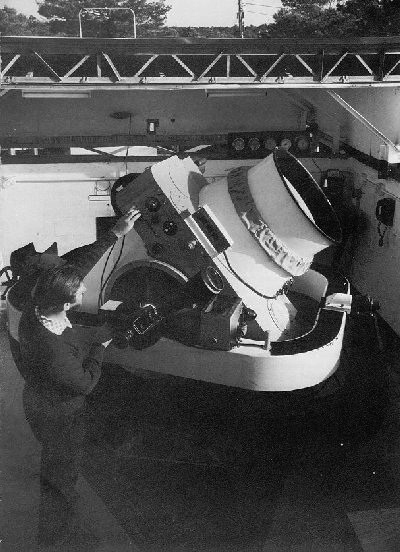Monday, July 30, 2012
Old Tech: Baker-Nunn Camera
The above image shows an operational Baker-Nunn camera. Image Credit: NASA
The Baker-Nunn camera was a large camera developed for tracking Earth satellites. The camera was named for its designers, American optical designer James G. Baker (1914-) and American engineer Joseph Nunn (1905-1968).
In 1956, Baker and Nunn collaborated to design and manufacture the camera. Each unit consisted of a very precise tracking system combined with an unusually large, wide-field camera for photographing large areas of the sky. Joseph Nunn was responsible for designing the mechanical elements, while Dr. Baker worked on the camera. The optics were fabricated by the Perkin-Elmer Corporation, and the camera was assembled by Boller and Chivens.
The Baker-Nunn optical design was successor to Baker-Schmidt. In 1940, Baker modified the Schmidt camera design to include a convex secondary mirror, which reflected light back toward the primary. A photographic plate was then installed near the primary, facing the sky. This design is called the Baker-Schmidt camera.
In Baker-Nunn, the camera's corrector plate was replaced with a small triplet corrector lens closer to the focus of the camera. Instead of a photographic plate, 55 mm Cinemascope film was used.
The Baker-Nunn camera was found to be a vital tool at the beginning of the US/Soviet space race, providing visual tracking data on the Soviet Union's Sputnik I satellite, which launched October 4, 1957.
Twelve Baker-Nunns were commissioned and used by the Smithsonian Astrophysical Observatory for their global satellite-tracking program, also known as the STP network. The network used the Baker-Nunn cameras from about August 1958 to the mid 1970s. Each unit designed for the network had a focal ratio of f/0.75 with a 20-inch aperture – each instrument weighed 3.5 tons and included a multiple axis mount, allowing it to follow satellites in the sky. At least one of the cameras was later refurbished for use in the Asteroid tracking program.
From One Era of Optical Tracking to the Next...
While I would not say there was a direct line of descent from the Baker-Nunn cameras and those cameras used by NASA's All Sky Fireball Network, I would at least say the two are kindred and that the former provided inspiration for the latter. Particularly since at least one Baker-Nunn was later repurposed for asteroid tracking.
The NASA All-sky Fireball Network is a network of cameras set up by the NASA Meteoroid Environment Office (MEO) with the goal of observing meteors brighter than the planet Venus, which are called fireballs. The collected data will be used by the MEO in constructing models of the meteoroid environment, which are important to spacecraft designers.
The network currently consists of 8 cameras, 6 of which are placed in locations in north Alabama, north Georgia, southern Tennessee, and southern North Carolina. The remaining 2 are located in southern New Mexico. The network is growing all the time, with plans to place a total of 15 cameras in schools, science centers, and planetaria in the United States, predominantly east of the Mississippi River, where there are few such systems.
Cameras in the network are specialized black and white video cameras with lenses that allow for a view of the whole night sky overhead.
The cameras have overlapping fields of view, which means that the same fireball can be detected by more than one camera. This allows managers to calculate the height of the fireball and how fast it is going. They can even work out the orbit of the meteoroid responsible for creating the fireball, which gives astronomers clues about whether it came from a comet or an asteroid. If the fireball is traveling slow enough, and makes it low enough, it is possible that it can survive to the ground as a meteorite.
To learn more about the program, visit NASA's All Fireball Network (fireballs.ndc.nasa.gov), part of NASA's Meteoroid Environment Office, www.nasa.gov/offices/meo .
-
Subscribe to:
Post Comments (Atom)

No comments:
Post a Comment